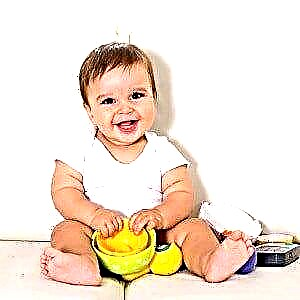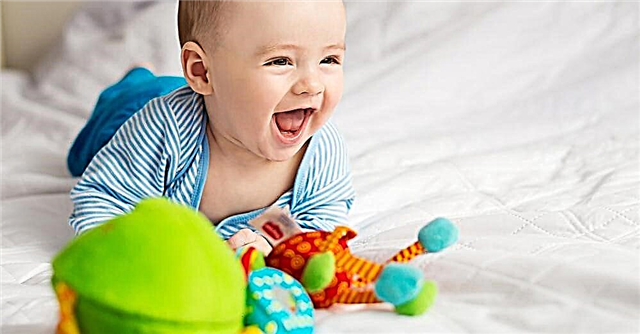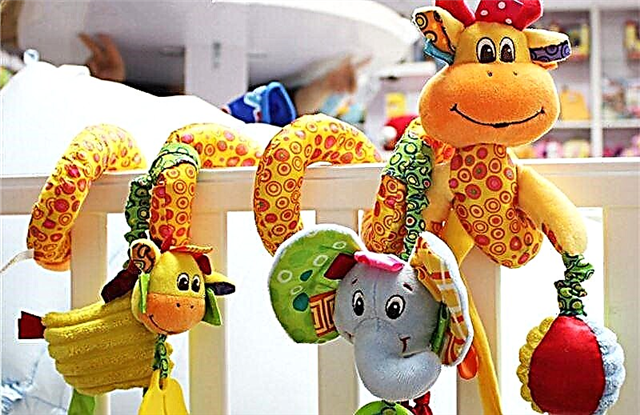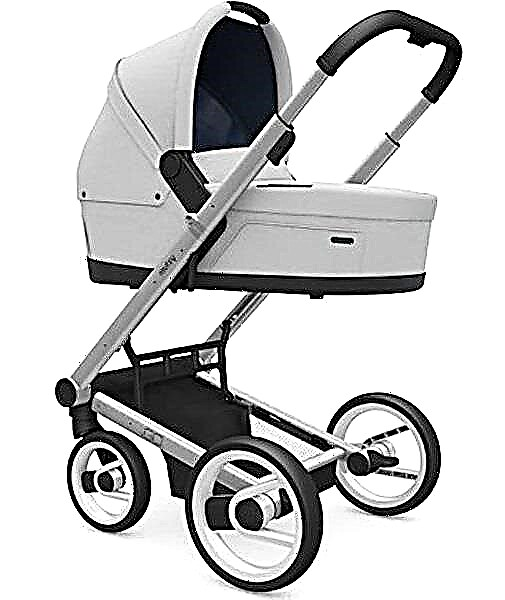The ninth month is another milestone in the life of a baby. Along with 1, 3 and 6 months, pediatricians call this milestone the epicrisis period - the moment when the skills and abilities of the baby are assessed in detail.
Neuropsychic development
Gross motor skills (general movements)
 what a 9-month-old child can do “perfectly well” is to sit on his own. The baby is able to sit down and sit without support for about 10 minutes. Also, from a sitting position, a nine-month-old baby can already or is still learning to lie down;
what a 9-month-old child can do “perfectly well” is to sit on his own. The baby is able to sit down and sit without support for about 10 minutes. Also, from a sitting position, a nine-month-old baby can already or is still learning to lie down;- the baby actively stands on its legs, holding tightly to the support with its hands. Usually, the side of the crib or sofa acts as a support. After standing for a while, the child descends on his own;
- especially mobile children, having learned to stand, can move close distances, moving from object to object and using them as a support;
- in the ninth month of life, the child continues to learn to crawl. It is quite rare at this stage to do it perfectly. Most of the crumbs still move on their bellies, crawling not forward, but backward. They begin to crawl well at about 10 months. To successfully master the skill, it is necessary to teach the child, stimulate him with exercises and frequent laying on his stomach;
- the motor skills of a child at 9 months old are enriched with dance skills. The kid, having heard a rhythmic melody, begins to perform dance movements. If at the same time mom or dad dance with him and hum a melody, the child tries with even more zeal.
Fine motor skills and actions with objects
 even more variety appears in actions with objects and toys. The kid does not just knock them or throw them on the floor. The child begins to perform actions with things depending on their properties. It rattles with a rattle, rolls a ball, puts small objects into larger ones;
even more variety appears in actions with objects and toys. The kid does not just knock them or throw them on the floor. The child begins to perform actions with things depending on their properties. It rattles with a rattle, rolls a ball, puts small objects into larger ones;- the baby has a pinched grip. With two or three fingers, he is able to pick up the smallest objects from the floor, even crumbs of bread.
When sending your toddler to crawl on the floor, be sure to vacuum before doing so. Finding every little thing, the child in most cases will pull it into his mouth. And this can lead to the fact that the baby chokes and a foreign body is in his respiratory tract;
- Of particular interest for a child at this age are various toys with movable mechanisms - levers and wheels.
Communication and interaction with the outside world
- children become more active in communication with other children. Seeing each other, they try to crawl closer, get to know each other, imitate their actions.
It is because of this sense of solidarity that, when he hears the cry of another baby, your child can also pick up this minor note and support with an anguished cry;
- at 9 months, the child is happy to copy the simple actions of adults. So, the kid will happily learn to play "Ladushki", "Ku-ku" and will diligently show with his pens how big he is.

Speech is active and understandable
- active and understandable speech continues to develop. The kid already knows his own name. Hearing it, the child quickly turns around at the sound or turns his head in search of it, demonstrates animation - smiles and starts waving his hands;
- when asked "Where?" tries to find a named object with his eyes;
- having heard speech, the child listens carefully, reacting to intonation. If the tone is threatening, loud, it can seriously upset the baby;
- some children at this age already quite consciously pronounce their first "ma-ma" and "pa-pa", which makes their parents boundlessly happy.
Physical development
The rate of weight gain from month to month continues its natural decline. This is due to an increase in the child's activity and motor capabilities. So, for the ninth month of life, the baby gains on average 450 - 500 grams.
Compared to birth weight, a 9 month old baby should add 6 kilograms. This criterion at 9 months also depends on the constitution, the nature of the diet, the frequency of diseases and gender. A boy can be significantly ahead of a girl in body weight.
Growth gains are also slightly reduced. By 10 months, the child will grow another centimeter - one and a half.
All these numbers are just an average digital expression of physical development. Each child is individual and is assessed by a doctor not only on the basis of specific tables.
Daily and nutritional regimen
A nine-month-old baby divides all of his sleep into 2 daytime sleep and one nighttime sleep. The total sleep time is approximately 13 hours. Some children like to get a little more sleep, others are already trying to get one day's sleep. True, the latter happens very rarely.
Many babies sleep all night. Basically, these are children who are fed with formula. It is more satisfying and stays in the stomach longer. The baby has to wake up in order to satisfy his feeling of hunger and the need for the act of sucking.
For the most part, a child's diet is almost adult food. If complementary feeding is started at 5 months, by 10 months the baby should already receive the main complementary foods - vegetables, cereals and meat.

Porridge
With normal gluten tolerance, you can include oatmeal, millet porridge in the diet. The child should also like the multi-cereal porridge with pieces of fruit. You can either cook them yourself or use the store ones.
It is advisable to wait up to a year with traditional semolina porridge. Digesting it will be difficult for a small stomach.
If the baby tolerates cow's milk well, eating milk porridge will only diversify the usual menu.
Vegetables
The range of vegetables eaten is also expanding. Almost anything is possible - zucchini, broccoli, cabbage, carrots, onions and beets. It turns out very tasty when you combine several vegetables with meat puree. This dish is the perfect lunch solution. Those who have already managed to acquire teeth can try this combination of products in the form of soups. Do not add salt and spices when preparing dinner.
Meat
The main types of meat that children under one year old eat are rabbit, turkey, and lean pork. If the baby is not allergic, tolerates cow's milk protein well, you can add veal.
You should be careful with chicken meat. Chances are good that it is loaded with antibiotics and growth hormones. As a last resort, cook exactly the breast. There will be less harmful substances.
It is better to buy steamed meat, tested by a laboratory - in a store or from reliable suppliers.
You can also buy industrial mashed potatoes. Only there, in addition to meat, there are five more names, including starch, salt, vegetable oil. The choice is always up to the parents.
Fruits, berries and juices from them
It will be a great addition to your main diet. The main thing is to pay attention to the child's reaction when introducing a new product. It is better to give preference to seasonal fruits and berries - apples, pears, plums, cherries, cherries and currants. It is better for children to feast on overseas delicacies after a year.
It is better not to abuse juices. Too much sugar in it often causes digestive problems and tooth decay.
Boil sugar-free compotes or serve freshly squeezed, diluted juice.
Dairy
This is cottage cheese and children's kefir. It is recommended to give them in the evening, together or separately.
Children with an allergy to cow's milk proteins should consult an allergist before introducing these products into the diet.
How to develop a child at 9 months?
The development of a child at 9 months largely depends on the parents. However, not only in the ninth month. The most important rule is not to limit the child's knowledge of the environment, and to protect this very environment.
Even though the baby is already grown up, carry it in your arms as much as you can afford (or as much as your back can afford). The maximum close contact with an infant up to one year old and even more is a guarantee of excellent relations with him in the future.
In the development of motor skills, the main task is to prepare the child for upright posture. Strengthening the muscles of the legs, back - these are our goals.
 Fitness ball exercises, gymnastics, swimming in the bathroom, stimulating crawling - all these activities are aimed at strengthening the muscle corset and developing coordination in the baby.
Fitness ball exercises, gymnastics, swimming in the bathroom, stimulating crawling - all these activities are aimed at strengthening the muscle corset and developing coordination in the baby.
Learning to crawl is also an important exercise. This expands the area of the surrounding space available for exploration. Crawling and moving, the baby learns to determine the position of his body, gets acquainted with its more thorough control.
Subsequently, children who crawled a lot in infancy are better oriented in unfamiliar places, it is easier for them to find a short path and master new routes.
To encourage the baby to crawl, lay it out on the floor more often, place your favorite toys in front of the child. So, trying to get them, the baby will try to crawl closer. Move the toys further and further each time. Every day the child will crawl better and better.
The sensory box will help in the development of fine motor skills. It is a container filled with various objects.
Everything that lies in such a box must be safe for the child.
Most of the space can be filled with dry beans or large pasta, for example. Small toys will help to complement the content. It will be interesting for the kid to dig, sort through all this variety and find pleasant surprises.
Show your child how to play "Okay", "Magpie-Crow" and "Ku-ku". These simple games from Soviet childhood will add even more variety to your leisure time together.
Be sure to talk to your baby, read rhymes to him, say nursery rhymes, sing before bed. Now the child will not be able, of course, to repeat all these words after you. But later, by the age of two, you will be surprised at his vocabulary.
Get small books made of thick cardboard or fabric and let the baby flip through the pages himself.
When to worry?
There is a certain list of what a child should be able to do at 9 months without fail:
- sits without support for up to 10 minutes;
- crawls or tries to crawl;
- stands on its legs at the support or makes the first attempts to do it;
- holds a mug with both hands;
- distinguishes his loved ones from strangers;
- reacts to his name.
If these skills and actions are not available, see your doctor.
The development of the child at 9 months is also assessed by a neurologist. If you have any problems, he will definitely tell you the ways to solve them.

 what a 9-month-old child can do “perfectly well” is to sit on his own. The baby is able to sit down and sit without support for about 10 minutes. Also, from a sitting position, a nine-month-old baby can already or is still learning to lie down;
what a 9-month-old child can do “perfectly well” is to sit on his own. The baby is able to sit down and sit without support for about 10 minutes. Also, from a sitting position, a nine-month-old baby can already or is still learning to lie down; even more variety appears in actions with objects and toys. The kid does not just knock them or throw them on the floor. The child begins to perform actions with things depending on their properties. It rattles with a rattle, rolls a ball, puts small objects into larger ones;
even more variety appears in actions with objects and toys. The kid does not just knock them or throw them on the floor. The child begins to perform actions with things depending on their properties. It rattles with a rattle, rolls a ball, puts small objects into larger ones;

